HOME >> METRO BEIJING
Channeling greatness
By Zhang Zihan Source:Global Times Published: 2013-7-22 19:08:02
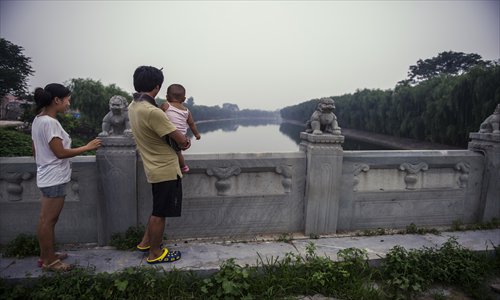
Locals gaze out on the Grand Canal from Tongyun Bridge. Local authorities have spent about 10 billion yuan restoring the little-known area. Photo: Li Hao/GT
With portions of it dating back as far as the 5th century BC, the Grand Canal long served as the economic artery of China. The 1,800 kilometer-long wonder of engineering starts in Beijing and winds down to Hangzhou, Zhejiang Province, passing through Hebei, Shandong and Jiangsu provinces along the way as it connects the Yellow and Yangtze rivers. Economic centers like Yangzhou sprouted up along its shores.Now, as river travel is more of a tourist attraction than means of commerce, Beijing and 34 other canal cities have banded together to apply to be a UNESCO World Heritage Site. Such a distinction would bring better protections and worldwide recognition. The badge can also translate to major tourist numbers. China currently has 45 UNESCO World Heritage Sites, including several within Beijing, such as the Forbidden City, Summer Palace and Temple of Heaven.
So far, municipal governments and State-owned enterprises have poured billions of yuan into restoring and constructing structures along the canal, according to the Tongzhou district government's website.
While the past significance of the waterway isn't under dispute, historians and locals question whether the canal in its current state merits the huge investment of time and money.
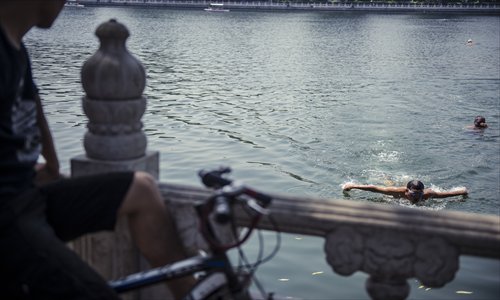
No longer a major commerce route, the Grand Canal's Houhai segment sees many swimmers.
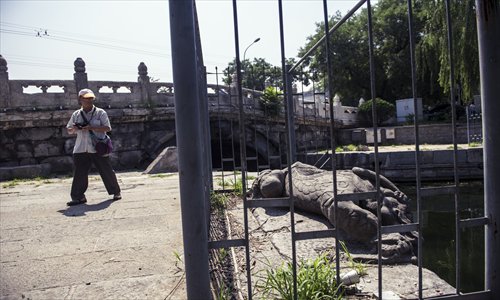
A relic near Wanning Bridge
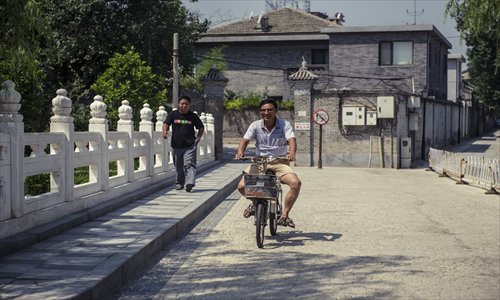
a bicyclist on Dongbuya Bridge over the Yuhe River
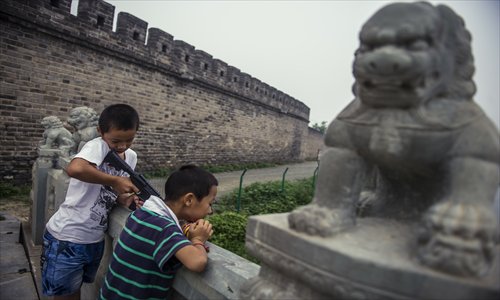
two boys playing near the Tongyun Bridge Photos: Li Hao/GT
A dried up historyMajor construction of the Grand Canal started in 486BC, during the Spring and Autumn Period (770BC-476BC) and ended in the 1290s under the rule of the Yuan Dynasty (1279-1368), according to History of Yuan, a text composed by the official bureau of the Ming Dynasty (1368-1644) in 1370. During the 1,800 years of construction, laborers and craftsmen completed the world's longest canal - nine times the length of the Suez Canal and 21 times that of the Panama Canal - using only simple tools and their bare hands.
The final stop and water gate of Beijing was Wanning Bridge in Di'anmen, Xicheng district. Though only some 10 meters long, this stone bridge decorated with white marble pillars once stood as the only entrance for ships and boats wanting to enter the capital.
Built during the rule of Kublai Khan (1215-1294), it divides the city and the Grand Canal, with the Yuhe River to the east and Shichahai to the west. When the Yuan Dynasty established Beijing as its capital, the city started to depend on the canal for its food supply.
The Tongyun Bridge in Zhangjiawan village, Tongzhou district, is another one of the few remaining architectural landmarks of the Grand Canal. According to the Beijing Municipal Commission of Tourism Development, this Ming Dynasty bridge was constructed in 1605, and is decorated with 36 stone lions, each with a different facial expression.
According to the Tongzhou district government's website, by 2010, close to 10 billion yuan ($1.50 billion, based on 2010 exchange rates) had been spent building up new, faux historic structures such as bridges around the Tongzhou segment of the canal.
Despite the money pumped into the project, the area is still far from well-known, and has nowhere near the tourist appeal of Wanning Bridge in the popular Houhai area.
And while both the Tongyun Bridge and Wanning Bridge have outlived the test of time, the majority of the architecture that once lined the Grand Canal has disappeared since the rise of modern transportation.
In their absence, the government has funded the construction of replicas built to mimic the ancient architecture. Walk just 400 meters east from the Wanning Bridge, and the freshly-made, government-constructed courtyards still give off the strong smell of wet paint.
Wang Jingwen, 68, lives close to Shichahai and said she doesn't understand the municipal government's decision to build copies of historic structures in the quest to become UNESCO-certified.
"The government claimed this is for the sake of the application ... for the Grand Canal. As a result, those who have been living here for generations were forced to leave. Their homes, the real, old hutong and courtyards, were replaced by expensive pseudo-classic architecture which no one can afford," she said.
"I don't get it," Wang continued. "Will the tourists really be attracted by these freshly built 'antiques'?"
Too little, too late
In response to this question, Metropolitan conducted an impromptu, unscientific survey on 10 tourists. Seven of them responded that they would love to "drop by for a few minutes" at the newly rebuilt canal. Three said they had no interest in it.
One of the three dissenting tourists, Zhang Mingren, 33, a storage company manager from Henan Province, said, "There are so many more attractive and real artifacts in this city. Why spend my time on replicas?"
Gao Wei, secretary general of the Beijing Folk Art Association, told Metropolitan that most of the relics connected to the Grand Canal have already been lost.
"In the old days, the Grand Canal served as the supply channel for the imperial capital. But the development of highways and railways has supplanted the canal's purpose and led to the decline and disappearance of canal-related business. The architecture surrounding the canal was abandoned, ruined or converted for other purposes," said Gao.
"The Grand Canal has died because its time has passed. How can you promote something which no longer exists?" Gao said. "The money should not be spent on building up cheap copies of ancient buildings, but used on preserving real old Beijing culture."
Posted in: Metro Beijing